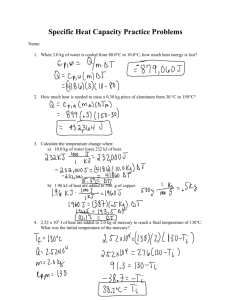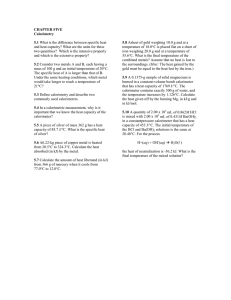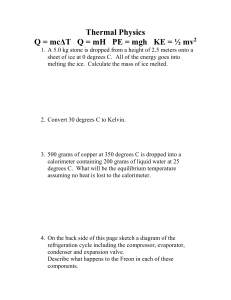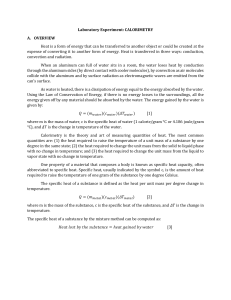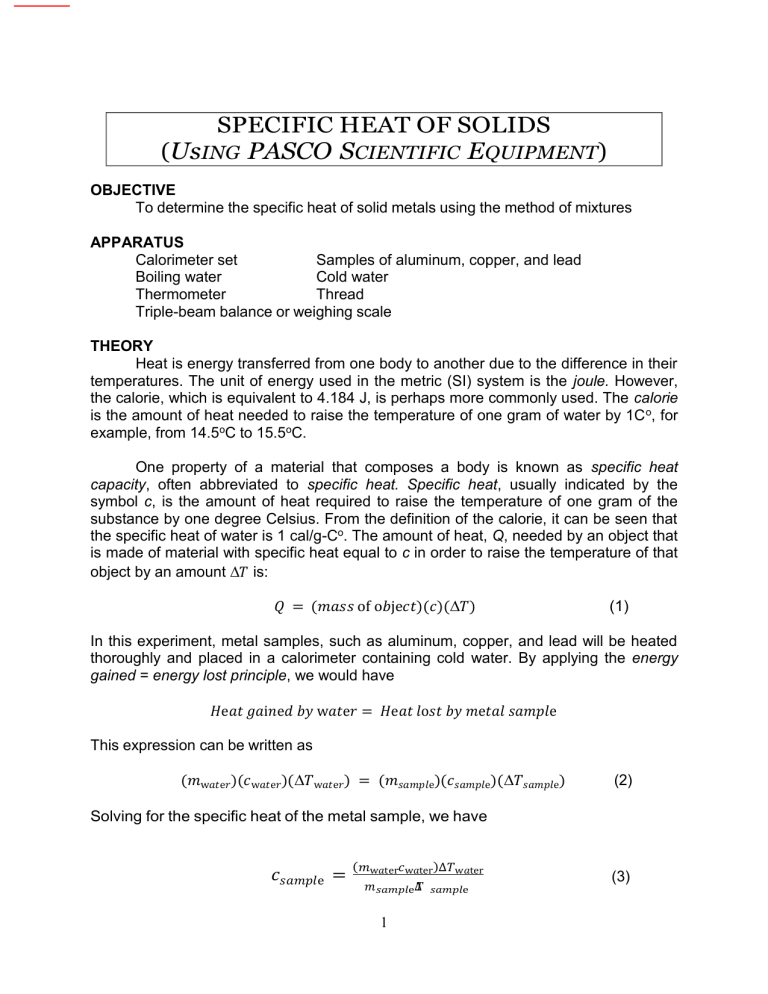
SPECIFIC HEAT OF SOLIDS (UsING PASCO SCIENTIFIC EQUIPMENT) OBJECTIVE To determine the specific heat of solid metals using the method of mixtures APPARATUS Calorimeter set Samples of aluminum, copper, and lead Boiling water Cold water Thermometer Thread Triple-beam balance or weighing scale THEORY Heat is energy transferred from one body to another due to the difference in their temperatures. The unit of energy used in the metric (SI) system is the joule. However, the calorie, which is equivalent to 4.184 J, is perhaps more commonly used. The calorie is the amount of heat needed to raise the temperature of one gram of water by 1C o, for example, from 14.5oC to 15.5oC. One property of a material that composes a body is known as specific heat capacity, often abbreviated to specific heat. Specific heat, usually indicated by the symbol c, is the amount of heat required to raise the temperature of one gram of the substance by one degree Celsius. From the definition of the calorie, it can be seen that the specific heat of water is 1 cal/g-Co. The amount of heat, Q, needed by an object that is made of material with specific heat equal to c in order to raise the temperature of that object by an amount 𝑇 is: 𝑄 = (𝑚𝑎𝑠𝑠 of o𝑏je𝑐𝑡)(𝑐)(𝑇) (1) In this experiment, metal samples, such as aluminum, copper, and lead will be heated thoroughly and placed in a calorimeter containing cold water. By applying the energy gained = energy lost principle, we would have 𝐻e𝑎𝑡 𝑔𝑎i𝑛e𝑑 𝑏𝑦 w𝑎𝑡e𝑟 = 𝐻e𝑎𝑡 𝑙o𝑠𝑡 𝑏𝑦 𝑚e𝑡𝑎𝑙 𝑠𝑎𝑚𝑝𝑙e This expression can be written as (𝑚w𝑎𝑡e𝑟)(𝑐w𝑎𝑡e𝑟)(𝑇w𝑎𝑡e𝑟) = (𝑚𝑠𝑎𝑚𝑝𝑙e)(𝑐𝑠𝑎𝑚𝑝𝑙e)(𝑇𝑠𝑎𝑚𝑝𝑙e) (2) Solving for the specific heat of the metal sample, we have 𝑐𝑠𝑎𝑚𝑝𝑙e = (𝑚w𝑎ter𝑐w𝑎ter)∆𝑇w𝑎ter 𝑚 𝑠𝑎𝑚𝑝𝑙e∆𝑇 𝑠𝑎𝑚𝑝𝑙e 1 (3) where 𝑚w𝑎𝑡e𝑟 is the mass of the water, 𝑚𝑠𝑎𝑚𝑝𝑙e is the mass of the metal sample, 𝑐w𝑎𝑡e𝑟 is the specific heat of water, 𝑇w𝑎𝑡e𝑟 is the temperature change of water, and 𝑇𝑠𝑎𝑚𝑝𝑙e is the temperature change of the metal sample. PROCEDURE CAUTION: This experiment involves the use of boiling water and the handling of HOT metal objects. Work carefully. Also, do not touch the lead sample, or the water sample that has come into contact with the lead sample. 1. Fill the electric steam generator to about half-way with water and start to heat it. 2. Measure the mass of the calorimeter 𝑚𝑐𝑎l (Figure 1). The calorimeter should be empty and dry. 3. Measure the mass of the metal sample 𝑚𝑠𝑎𝑚𝑝𝑙e (Figure 2). Record your measurements. 4. Attach a thread to the metal sample and suspend it in boiling water. Allow a few minutes for the sample to heat thoroughly. 5. Fill one-half of the calorimeter with cold water. Use enough water to cover the metal sample. 6. Measure the initial temperature of the boiling water, 𝑇𝑏oi𝑙i𝑛g w𝑎𝑡e𝑟, and record. [Although this should be less than 100°C (because the laboratories are not at sea level), the actual temperature is greater than 100°C. This is because the water in the heater is not pure.] 7. Measure the initial temperature of the cold water, 𝑇𝑐o𝑙𝑑, and record. 8. Immediately after measuring the temperature of cold water, remove the metal sample from the boiling water, quickly wipe it dry, and then suspend it in cold water in the calorimeter. The sample should be completely immersed, but it should not touch the bottom of the calorimeter. 9. Slowly and carefully stir the water by moving the metal sample up and down (like a tea bag) and note the highest temperature attained by the water as it comes into thermal equilibrium with the metal sample. 10. Record this as 𝑇fi𝑛𝑎𝑙. After taking the temperature, measure and record, the total mass of the calorimeter with water and metal sample 𝑚𝑡o𝑡𝑎𝑙. Subtract the mass of calorimeter, 𝑚𝑐𝑎𝑙, and the mass of sample, 𝑚𝑠𝑎𝑚𝑝𝑙e, from 𝑚𝑡o𝑡𝑎𝑙 to get the mass of water, 𝑚w𝑎𝑡e𝑟. 𝑚w𝑎𝑡e𝑟 = 𝑚𝑡o𝑡𝑎𝑙 – (𝑚𝑐𝑎𝑙 + 𝑚𝑠𝑎𝑚𝑝𝑙e) (4) 11. Compute for the change in temperature of the water, 𝑇w𝑎𝑡e𝑟, when it came into contact with each metal sample and the change in temperature of the metal sample, 𝑇𝑠𝑎𝑚𝑝𝑙e, using equations 5 and 6 below. Record your results. 𝑇w𝑎𝑡e𝑟 = 𝑇fi𝑛𝑎𝑙 − 𝑇𝑐o𝑙𝑑 𝑇𝑠𝑎𝑚𝑝𝑙e = 𝑇𝑏oi𝑙i𝑛g w𝑎𝑡e𝑟 − 𝑇fi𝑛𝑎𝑙 2 (5) (6) 12. Repeat instructions 1 to 11 for the other two metal samples. 13. Using equation 3 and your collected data, calculate the specific heats of aluminum, copper, and lead. Record your results. 14. Compare your results with the standard value by calculating the percentage error. r Fig. 1. PASCO calorimeter and thermometer Fig. 2. Metal samples 3 4 Laboratory Group # & Name: Date Performed: Course Code & Section: Group Members: DATA SHEET SPECIFIC HEAT OF SOLIDS (Using PASCO Scientific Equipment) Material of metal sample Mass of calorimeter, mcal(g) Mass of metal sample, msample (g) Mass of calorimeter, water, and metal sample, mtotal (g) Mass of water, mwater (g) Temperature of boiling water in the heater, Tboiling water (oC) Temperature of water, Tcold (oC) Equilibrium temperature of water and metal sample, Tfinal (oC) Temperature change of water, Twater (Co) Temperature change of sample, Tsample (Co) Specific heat of water, cwater (cal/gCo) Calculated Specific Heat, cs (cal/gCo) (use equation 3) Standard Value of Specific Heat (cal/gCo) (see Table of Physical Constants) Percentage error Aluminum ANSWERS / SAMPLE CALCULATIONS 5 Copper Lead PHYSICS DEPARTMENT College of Science De La Salle University - Manila SPECIFIC HEAT OF SOLIDS Guide Questions 40% of the Written Report (Group Report) Grade 1. List the materials used (aluminum, copper, lead, and water) according to their specific heat from lowest to highest. 2. Which material (aluminum, copper, lead) had the largest change in temperature (∆𝑇𝑠𝑎𝑚𝑝𝑙e)? What observations can you draw about these values? 3. Which material (aluminum, copper, lead) increased the temperature of water by the greatest amount (∆𝑇w𝑎𝑡e𝑟)? Is this what you expected? Explain why this is so. 4. If the metal specimens placed in the calorimeter containing cold water was wet, how would the value obtained for specific heat be affected? Why? 5. Application question: A king decreed that there be made three equally massive coffee mugs, one made of gold for him, one of iron for his army chief and one of aluminum for the court jester. The king always complains that his coffee is too hot while the jester complains his is too cold. Can you think of an explanation for this? The mugs hold equal volumes of coffee. 6
